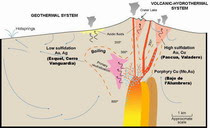
Future Energy, Environment Friendly and Renewable
 With the combined high and low enthalpy geothermal resources, the potential estimated by Directorate General of Geology and Mineral Resources is more than 27,000 MW which makes Indonesia the country with the highest geothermal potential in the world. Indonesia has however, developed only less than a thousand MW of geothermal power. The Indonesian government is planning to utilize the big geothermal energy resource as a leading alternative energy to substitute fossils that may be fulfilling Indonesia’s growing demand for electric power during the 21st century.
With the combined high and low enthalpy geothermal resources, the potential estimated by Directorate General of Geology and Mineral Resources is more than 27,000 MW which makes Indonesia the country with the highest geothermal potential in the world. Indonesia has however, developed only less than a thousand MW of geothermal power. The Indonesian government is planning to utilize the big geothermal energy resource as a leading alternative energy to substitute fossils that may be fulfilling Indonesia’s growing demand for electric power during the 21st century. The field occurs within a Quaternary volcanic highland with several volcanic centers including Gunung Urug (+2201 masl), Gunung Patuha (+2414 masl) and Patuha Selatan (+2390 masl). The surface rocks in the project area is primarily covered andesitic lavas and pyroclastic rocks, the dacitic lavas dome is distinctly observed at Gunung Urug and Patuha Selatan. Most of drillsites are located at the elevation of 1800-2200 masl. An eastward extension of the same mountain range includes the Wayang Windu geothermal field, located around 30 kilometer to the east. The land in Patuha area is used primarily for growing tea and protected forest.
The field occurs within a Quaternary volcanic highland with several volcanic centers including Gunung Urug (+2201 masl), Gunung Patuha (+2414 masl) and Patuha Selatan (+2390 masl). The surface rocks in the project area is primarily covered andesitic lavas and pyroclastic rocks, the dacitic lavas dome is distinctly observed at Gunung Urug and Patuha Selatan. Most of drillsites are located at the elevation of 1800-2200 masl. An eastward extension of the same mountain range includes the Wayang Windu geothermal field, located around 30 kilometer to the east. The land in Patuha area is used primarily for growing tea and protected forest. There is a clear magmatic contribution to the steam discharged at Kawah Putih, based on the extremely low pH (1) and high chloride levels (17000 ppm) in the lake water at the Kawah, which is located at elevation of 2240 masl. The hot springs groups occurs in the northern part of Kawah Putih at Cimanggu, Rancawalini, and Barutunggul. These springs discharge dilute, neutral pH Na-HCO3-SO4-Cl waters. Others warm springs discharge at Cisaat, southwest of Kawah Cibuni, and at Cibunggaok, southwest of Gunung Urung. A cold gas seep appears at Kawah Tiis, about 3 kilometers southwest of Gunung Urug. Two cold, mineralized springs discharging dilute, acid-chloride-sulfate water emerge about 1.5 kilometer east of Kawah Putih. The presence of active thermal features and very young volcanism made the field one of the attractive target for commercial development.
There is a clear magmatic contribution to the steam discharged at Kawah Putih, based on the extremely low pH (1) and high chloride levels (17000 ppm) in the lake water at the Kawah, which is located at elevation of 2240 masl. The hot springs groups occurs in the northern part of Kawah Putih at Cimanggu, Rancawalini, and Barutunggul. These springs discharge dilute, neutral pH Na-HCO3-SO4-Cl waters. Others warm springs discharge at Cisaat, southwest of Kawah Cibuni, and at Cibunggaok, southwest of Gunung Urung. A cold gas seep appears at Kawah Tiis, about 3 kilometers southwest of Gunung Urug. Two cold, mineralized springs discharging dilute, acid-chloride-sulfate water emerge about 1.5 kilometer east of Kawah Putih. The presence of active thermal features and very young volcanism made the field one of the attractive target for commercial development. The Island of Java has numerous volcanic centers along its E-W axis which is located near the boundary of two major lithospheric plates, the Indian Ocean-Australian plat on the south and the Eurasian plate to the north (Figure 1). Collision of these two plates has resulted in the formation of a large subduction zone (the Java Trench), which lies offshore and parallel to the southern coast of Java Island. The presence of very young volcanoes throughout much of Indonesia results from the ascension of melted crustal material from the subducted lithospheric plate.
The Island of Java has numerous volcanic centers along its E-W axis which is located near the boundary of two major lithospheric plates, the Indian Ocean-Australian plat on the south and the Eurasian plate to the north (Figure 1). Collision of these two plates has resulted in the formation of a large subduction zone (the Java Trench), which lies offshore and parallel to the southern coast of Java Island. The presence of very young volcanoes throughout much of Indonesia results from the ascension of melted crustal material from the subducted lithospheric plate. Figure 2 is a simplified geological map of the project area taken from Sukhyar et al. (1986). The Dieng mountain complex appears to have attained its present shape as results of sequence of events. The oldest rocks mapped in the area are pyroxene andesite and basaltic andesite lavas and outcrop surrounding the Geothermal field. These great quantities of magma were erupted around between 2.5 to 3.6 million years (my) before the present time (bp).
Figure 2 is a simplified geological map of the project area taken from Sukhyar et al. (1986). The Dieng mountain complex appears to have attained its present shape as results of sequence of events. The oldest rocks mapped in the area are pyroxene andesite and basaltic andesite lavas and outcrop surrounding the Geothermal field. These great quantities of magma were erupted around between 2.5 to 3.6 million years (my) before the present time (bp).






